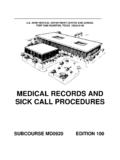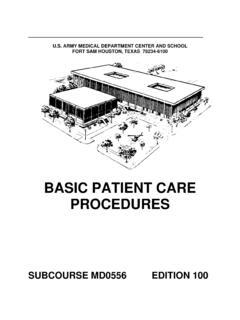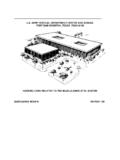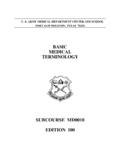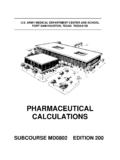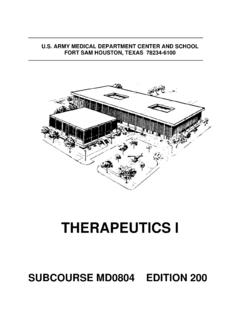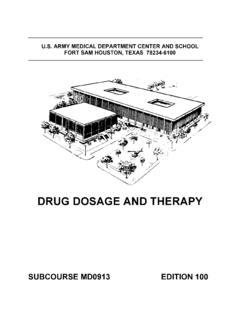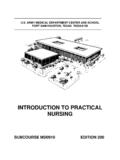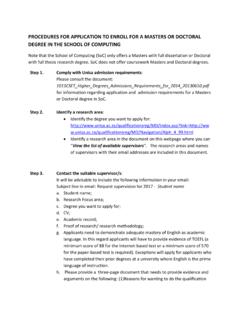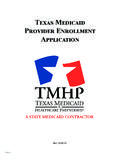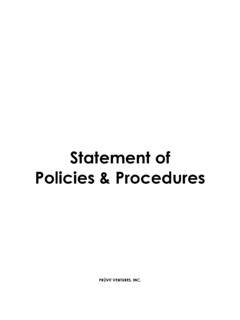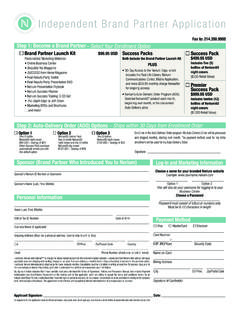Transcription of STERILE PROCEDURES - Nursing Training and …
1 ARMY MEDICAL DEPARTMENT CENTER AND SCHOOL FORT SAM HOUSTON, TEXAS 78234-6100 STERILE PROCEDURES SUBCOURSE MD0540 EDITION 100 DEVELOPMENT This subcourse is approved for resident and correspondence course instruction. It reflects the current thought of the Academy of Health Sciences and conforms to printed Department of the Army doctrine as closely as currently possible. Development and progress render such doctrine continuously subject to change. ADMINISTRATION For comments or questions regarding enrollment, student records, or shipments, contact the Nonresident Instruction Branch at DSN 471-5877, commercial (210) 221-5877, toll-free 1-800-344-2380; fax: 210-221-4012 or DSN 471-4012, e-mail or write to: COMMANDER AMEDDC&S ATTN MCCS HSN 2105 11TH STREET SUITE 4192 FORT SAM HOUSTON TX 78234-5064 Approved students whose enrollments remain in good standing may apply to the Nonresident Instruction Branch for subsequent courses by telephone, letter, or e-mail.
2 Be sure your social security number is on all correspondence sent to the Academy of Health Sciences. CLARIFICATION OF Training LITERATURE TERMINOLOGY When used in this publication, words such as "he," "him," "his," and "men" are intended to include both the masculine and feminine genders, unless specifically stated otherwise or when obvious in context.. TABLE OF CONTENTS Lesson Paragraphs INTRODUCTION 1 COMMUNICABLE DISEASES Section I. Review 1-1--1-4 Section II. Prevention and Control of Infection 1-5--1-8 Section III. Bloodborne Pathogens 1-9--1-12 Exercises 2 MEDICAL ASEPSIS 2-1--2-5 Exercises 3 SURGICAL ASEPSIS AND STERILE TECHNIQUE 3-1--3-8 Exercises 4 PROCEDURES USED IN WOUND CARE Section I.
3 Changing a STERILE Dressing 4-1--4-8 Section II. Wound Irrigation 4-9--4-10 Section III. Preparing a Wound for OperativeTreatment 4-11-4-14 Exercises 5 ISOLATION Section I. Types of Isolation 5-1--5-2 Section II. Isolation Techniques 5-3--5-10 Exercises MD0853 i MD0853 ii CORRESPONDENCE COURSE OF THE ARMY MEDICAL DEPARTMENT CENTER AND SCHOOL SUBCOURSE MD0540 STERILE PROCEDURES INTRODUCTION A cardinal rule in the medical field is to not do more harm than good to the casualty. This is the reason we must be careful to protect the patient from infection or disease while attempting to treat him.
4 There are times in combat situations when you may not have the time to wash your hands or to wear gloves and mask as you work with the casualty. This is understandable. You must work quickly to help the casualty. This subcourse discusses communicable diseases and how they are transmitted, medical asepsis, surgical asepsis, the purposes of dressings, types of dressing materials, how to change a STERILE dressing, and how to irrigate a wound. Subcourse Components: This subcourse consists of five lessons. The lessons are: Lesson 1. Communicable Diseases Lesson 2. Medical Asepsis. Lesson 3. Surgical Asepsis and STERILE Technique. Lesson 4. PROCEDURES Used in Wound Care. Lesson 5.
5 Isolation. Credit Awarded: To receive credit hours, you must be officially enrolled and complete an examination furnished by the Nonresident Instruction Branch at Fort Sam Houston, Texas. Upon successful completion of the examination for this subcourse, you will be awarded 6 credit hours. You can enroll by going to the web site and enrolling under "Self Development" (School Code 555). A listing of correspondence courses and subcourses available through the Nonresident Instruction Section is found in Chapter 4 of DA Pamphlet 350-59, Army Correspondence Course Program Catalog. The DA PAM is available at the following website: LESSON ASSIGNMENT LESSON 1 Communicable Diseases.
6 LESSON ASSIGNMENT Paragraphs 1-1 through 1-12. LESSON OBJECTIVES After completing this lesson, you should be able to: 1-1. Identify the major types of pathogens. 1-2. Identify the types of communicable diseases. 1-3. Identify the PROCEDURES to follow to prevent wound infection. 1-4. Identify the body's defense against diseases. 1-5. Identify the signs and symptoms of infection. 1-6. Define the idea of universal precautions. SUGGESTION After completing the assignment, complete the exercises at the end of the lesson. These exercises will help you to achieve the lesson objectives. MD0540 1-1 LESSON 1 COMMUNICABLE DISEASES Section I.
7 REVIEW 1-1. INTRODUCTION Infections are prone to develop in wounds of violence. Therefore, the prevention and control of infection is one of the chief problems in emergency medical treatment and care of wounded patients. The development of infection, particularly in large wounds, increases the period of morbidity since infection produces further destruction of tissue and suppresses the healing process. Infection also has a marked effect on the final result of the injury and the mortality. Tissues destroyed by infection are usually replaced by scar tissue, which may have a harmful effect on function as well as appearance. 1-2. DEFINITIONS Some of the terms related to infection are defined below: a.
8 Antibiotic. An antibiotic is a substance produced by microorganisms, which kills bacteria and other microorganisms. It is used in treating infectious diseases. b. Antiseptic. An antiseptic is an agent that may kill pathogens, but more often retards their growth. c. Aseptic. Aseptic is a state of being STERILE (free from septic material). d. Contaminated. Contaminated means compromised by the presence of bacteria or harboring pathogenic agents. e. Infection. An infection is produced by an invasion of disease-producing pathogens which multiple in the body. f. Malaise. Malaise means body discomfort. g. Morbidity. Morbidity refers to the condition of being diseased or to the ratio of sick to well persons.
9 This is not to be confused with mortality, which is the death rate. h. Pathogen. A pathogen is a disease-producing organism. i. Phagocyte. A phagocyte is a form of leukocyte (white blood cell) that ingests microorganisms or other cells. MD0540 1-2 j. Septic. Septic refers to something that is affected by pathogens, their toxins, or to something putrid. k. Septicemia. Septicemia refers to the widespread distribution of infective bacteria through the bloodstream. It is also called "blood poisoning." l. STERILE . STERILE means free from live pathogens and other live microorganisms.
10 1-3. CLASSIFICATION OF PATHOGENS a. Infectious Agents. Infectious (pathogenic) agents of one kind or another are everywhere that life exists. They inhabit the air, soil, and water. In the body of humans and animals, they inhabit waste products, skin, respiratory tracts, and alimentary tracts. Agents capable of harming man include bacteria, viruses, and fungi. The primary basis for the development of infection is the growth of bacteria within the wound itself. All injuries in which the skin has been penetrated are contaminated by bacteria. Following are some of the types of pathogens. (1) Bacteria. Bacteria are microscopic one-celled plant organisms. The group names sometimes describe the infection.
